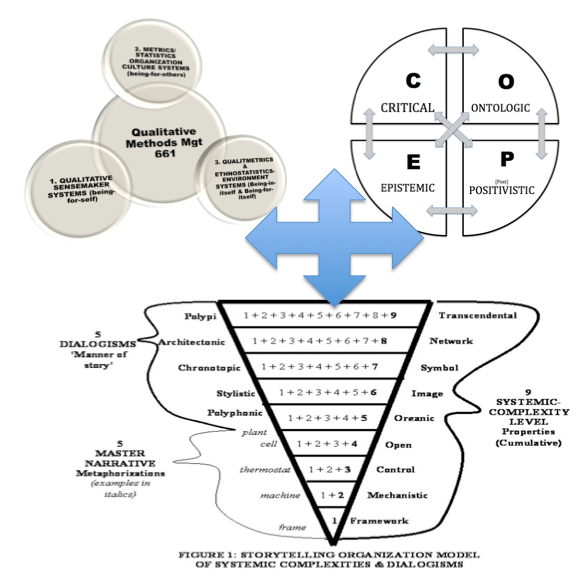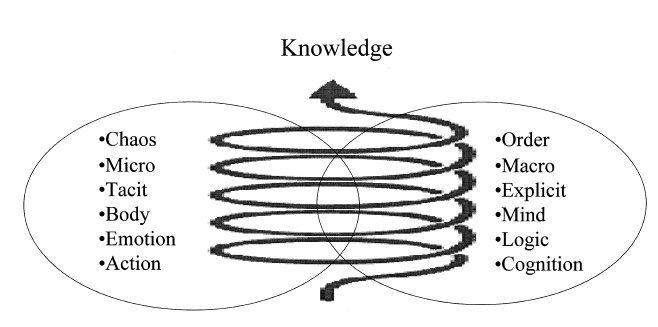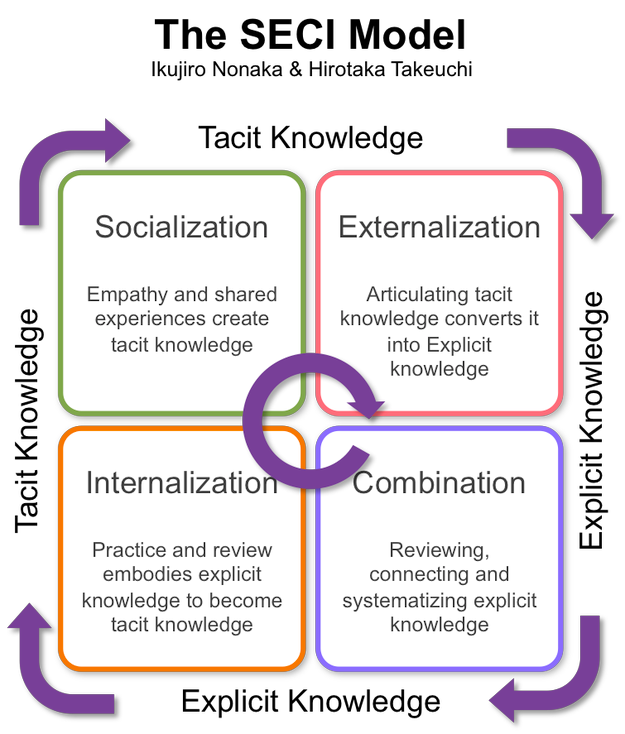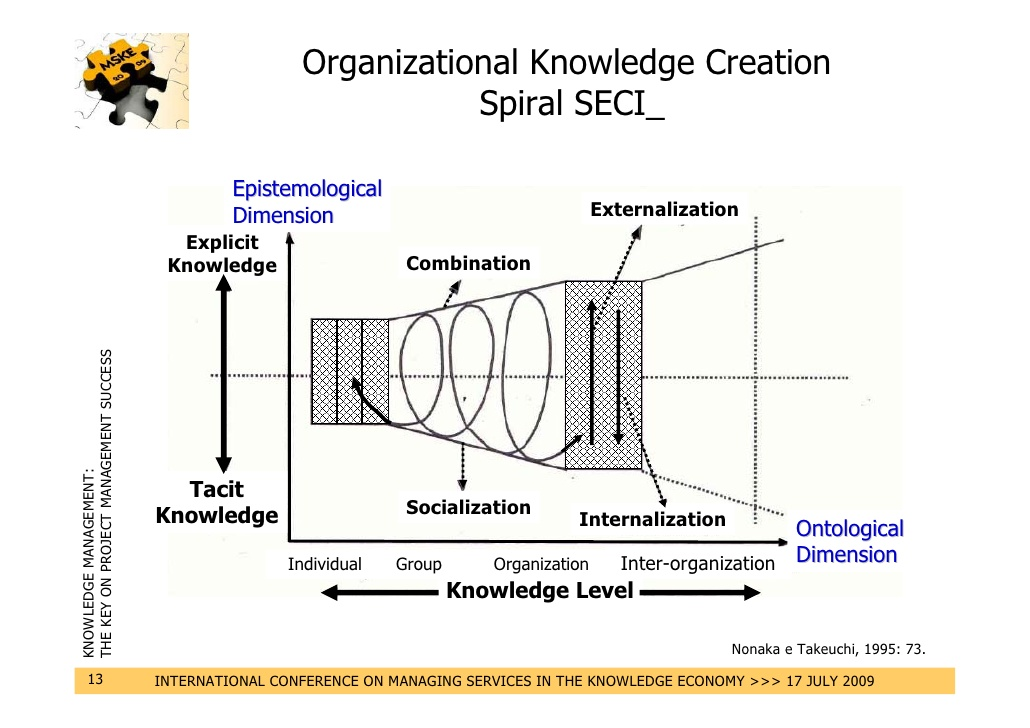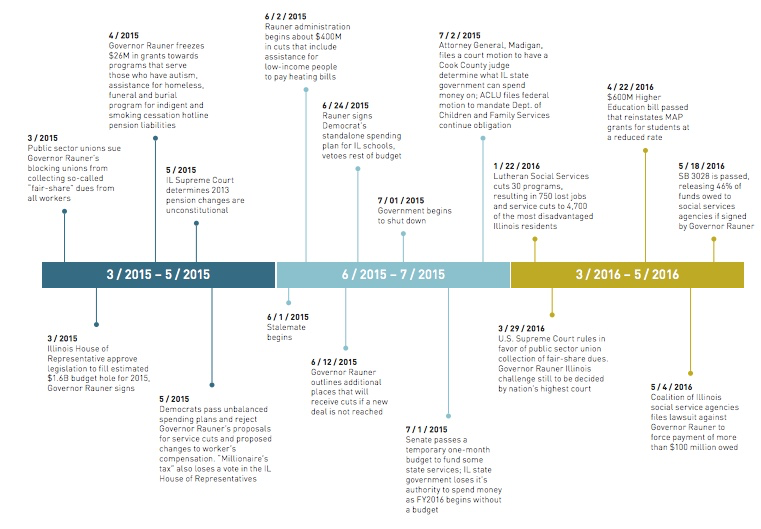Organizational Research Methods: Storytelling in ActionDavid M. Boje Book being prepared for Routledge, due March 2018 To cite this document: Boje, David M. (2018) "Organizational Resarch Methods: Storytelling In Action", (March 15), URL = <https://davidboje.com/ORM_Storytelling_in_Action_Book/index> |
STREAM - Plato's Dialectic of Double Twisted Spiral
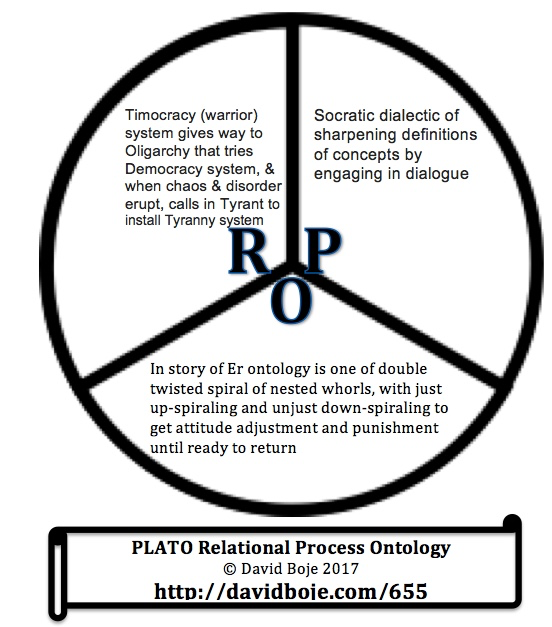
Figure 1: Plato Relational Process Ontoogy
Here I want to begin with Plato's 'double twisted spiral' model (as I call it). It has some implications for ways relational process ontology could study spiraling in organizations. I will then look at Plato's conversational dialectics as a way of tapping into the kind of interviewing that Hawthorne studies did once they tossed the old method. Our problem in organization systems research, is much of it is based on the old interviewing scheme (called semi-structured interviewing). The dialectical conversation was less structured yet got at deeper issues of context and ontology.
Figure 2 - The Upward and Downward Twisted Spiral with 8 Whorls in the Story of ‘Er’ by Plato (original drawing by D. M. Boje 27 July 2017)
Plato envisioned the cosmos as eight whorls, nested one in the other, on which the stars and planet spun in the orbits about the Earth. They spin about a weavers spindle and hook. We know now that the story of Er does not match today's Copernican understanding of the Sun as at the center of the solar system, one one of the spiraling arms of the Milky Way galactic spiral. So your challenge is to draw a spiral with upward and downward whorls and whirls, that has what you consider the main dialectical forces. For Plato there were several dialectics: the spiritual and the earthly, chance and fate, strife and love, and so on.
Begin your systems theory research by giving your own interpretation of Plato's story of Er, in the Republic. Please open the Republic and read the story yourself, and draw your own image and interpretation. You will need to upgrade the whorls. For Plato there were several dialectics: the spiritual and the earthly, love and strife, concord and discord, sameness and difference, and so on. Your challenge is to declare what dialectical forces and counterforces you believe organization systems to be manifesting.
Plato, a student of Socrates, treats dialectic as a pedagogical way to teach virtue ethics by doing Socratic question and answer sessions (dialogues). It begins with inviting someone else to dialogue, to guide their soul, by critiquing and refuting. Each dialogue starts by asking for a definition of a concept, which is then questioned, perhaps refuted. Kirkeby (2009: 13, The New Protreptic) refers to Plato's dialectic as a conversation (dialogue) where thinking and speaking are two sides of the same coin, in order to reach happiness by avoiding the misuse of power, what Kirkeby (2009: 15) calls softening the tyrant leader. The Greek 'protreptic" means "to confront with (gently but insisting)", "to urge" (Kirkeby, 2009: 27). The Protreptic is about a dialectic to coach others toward, integrity, authenticity by helping others to examine their own lives. The Protreptic is a "license to think, both with the intellect, and with the heart" to find the good, the just, the equitable, and the beautiful (IBID, p. 27). Socrates, Plato and Aristotle where Protreptic guides, coaches to the leaders of their day, consultants changing leaders and their organizations (or kingdoms), according to an "existential code" (IBID, p. 27). The aim is to get at the existential aspects of life, by modes of deep self-reflection and to strengthen ethical imagination (IBID. pp.28-29).
By way of introduction, let's look at Plato's Twisted Double Spiral, and then discuss some history of systems thinking.
Plato's understanding of spiraling systems. Systems research is about storytelling and this is my interpretation of Plato's story of Er, in the Republic. Please open The Republic and read the story yourself, and draw your own spiraling interpretation.
A story is not an ontological story, if its ripped out of context, branded and reduced into a narrative, with all kinds of story content left on the editing floor, but the story of how this happened can be very much a story, and that is why I study the transformative movement and dialectical complicity of antenarrative. The opportunity here is to develop an antenarrative interviewing approach. Antenarrative processes are ontological, and this approach will locate antenarrative in Heideggerian ontology. Antenarrative is the before-narrative coheres, the 'bets' being made on the arriving future, the beneath (fore-conception), the between (fore-structure), and becoming of care (fore-care).
There are no steps in Plato dialectics (or Kirkeby's Protreptic), but to get you started I will suggest some using the opening dialectical question: 'What is your definition of system?'
Toward Steps for Relational Process Dialectical Interviewing Conversations
Step 1: Seek the contrary of the definition of the concept by negation by listening to the voice of the other. You say a system is the relationship between the whole and the parts. Is this not the definition of a mechanical system? Do you want to change your definition? OK, you say in the new definition a system is an organic whole with feedback loops for inputs, throughputs and outputs? Is this always the case. How do you explain that sometimes there is no organic whole? And OK, how does your answer explain that parts are being added, others changes, and still others jettisoned?
Step 2: Question differences among types and the contraries. You say there are differences between a formal system, a mechanistic system (aka closed system), an open system, and an organic system? You say the difference is mainly between the closed and the open systems? What are they closed from and open to? Environment? Well, if environment is so important, should it be part of your definition of system concept? What different processes constitute what you mean by system?
Step 3: Questions about the subdivisions of the kinds of forms. OK, so a system can be framework (way of thinking), mechanistic, control (aka cybernetic with deviation counteracting feedback loops), open system (deviation amplifying), organic systems that are natured, image systems, network systems, and transcendental systems. You are an obvious fan of Kenneth Boulding and Louis Pondy.
Figure 3- Beyond the hierarchical systems model (above is combined from Boje (2008) and Boje (2014))
Do you believe these 9 kinds of systems are arranged in reality in a hierarchy? Why does Pondy say question mark ('?') instead of Boulding's 'transcendental system'? Your mechanistic system seems to have the metaphor of machine, and your control system (deviation counteracting cybernetic) is that other machine and so is the thermostat? The open system is a cell, but then how is that different from the organic with is a plant? The image, symbol, network, and transcendental seem to have some very humanistic qualities. What happened to sociomatieralism. Where is the dialectic in all this? Are organizations hybrids of all nine types? If so, why is there in your definition a natural order of type one to type nine. Can I have an image control system, with out having an open or organic level of system?
Step 4: Question the distinctions implied between ideal forms and everyday experience? What is your experience of a perfect organizational system? What is a perfect open system adaptive relation with its environment? Is there a gap between your ideal types of systems and life in the sociomaterial world of organizations? Which possesses the greater reality the environment or the [organizational] system? What is the environment? You say in organization studies, the environment is just other organizations? That seems a bit limiting. Are there no trees, birds, rivers, or mountains in the environment? Why are these ecosystems left out of organization systems thinking? What kind of thinking is systems thinking? How does this system thinking play out in societies? So if I understand you correctly, you have a pre-conceptual experience of system, but when you try to define it, the definition falls short. Is there some new definition of system you wanted to attain?
Step 5: Push the Socratic dialectic questioning until the person has no idea of what the concept actually means, or the definition is no so robust it attains the true nature of the thing, and you have arrived ad true storytelling? OK, it seems to me that organizational systems are complete fictions? So, you are saying that there exists an empirical phenomena called organizational systems? How do you define it? I don't find much wisdom (or understanding) in the empirical. I am a philosopher of wisdom. How can people be happy in this organizational system? You say people are living a life of human suffering, domination, and central control, especially in control systems. How is that goo for the whole individual, the whole group, the family? Is a family as system? So, organizational are like families, but they are not families, with the one exception of the family business. What happened to the 'transcendental system'? Surely the healthy should seeks a system that has harmony. It seems systems of organizations are full of contradictions. Each new CEO or president or ruler puts their personal 'stamp' on the system. That does not seem very dialectic to me/ You say systems change overtime, and there is an opposition of top-down systems and bottom-up systems. Is this relationship dialectical, or is it sequential, or what? OK, now you are saying that systems can self-organize if they are not over-controlled from the top and the people who span the boundaries have some autonomy to boundary-span. I am still trying to sort out the environment thing, how the whole system of environment is greater than the sum of the parts of the organizations? So this thing called requisite variety is important to you? Can the system change into its opposite. Plato wrote about the oligarchy becoming tyranny, that becomes democracy and back to one of the other two choices (See The Republic). Your definition of system must be wrong if it is sequential, frame becomes mechanistic, becomes control, becomes open that becomes organic, and so on? I don't get what you mean by systems are just socially constructed? Who is constructing them? If everyone is constructing them, how is there any unity or harmony? I am back to thinking system must be a fiction. Could it be system is both/and both fictive search for an ideal form, and falling short in the 'real' world, not living up to what it could become? Do you see, this could be the definition you and I are searching for? Do you see how this definition is the opposite and quite fare from where we started?
Plato uses poetics and dialectical conversation to move beyond the factual and the rational understanding of a concept. We have been using the example of organizational systems. Next, I want to share some poetics, and show how it can develop into a twisted double spiral understanding. Let's return now the more about the 'double twisted spiral.'
This is my own interpretation of Plato’s story of Er and the image of the upward and downward twisted spiral, shaped like 8 nested hourglasses, each with a Siren singing a note, and the whorls themselves turned by the three sisters of Fate sing their songs of present (Clothos), past (Lachesis), and future (Atronpos). The two conic nested spirals (upper and lower world, heaven and heal) are turning their outer whorls in opposite directions, and the two vortices are twisted and joined at the center. For Plato those living a just life would ascend in the upward spiral and those living an unjust life would descend into the abyss.
The whole nested 8-whorl, double conic, or ‘twisted spiral’ had one overall motion, revolving in one direction, with inner seven double-whorls moving in some opposite directions, with varying velocities. The upper whorl part is entangled (to spin opposite) the counterpart lower whorl. A siren stood on their separate whorls, each humming a note, all in perfect harmony. Plato interpreted the cosmos as a nesting of the larger 8th whirl and the tighter turning 1st whorl path of the Earth.
Plato put them in this order.
8th whorl of fixed stars
7th whorl of the Sun’s orbit lighting the Moon
6th whorl of Jupiter
5th whorl of Mercury orbit
4th whorl of Mars orbit
3rd whorl of Venus orbit
2nd whorl of Saturn orbit
1st whorl of the EarthTwisted Spiral of 8 Whorls In what I will call the ‘twisted spiral’ eight whorls, turned upward and downward, in hourglass shape, revolved around a weaver’s hook and spindle, in a single vortex whirl. The spindle pierced the twisted spiral of eight whorls in overall shape of nested hourglasses. This spindle was made of a diamond-like substance and along its axis were eight whorls of mixed substances, and each nested inside the other. The inner whorls were smaller and smaller rims, and the outermost whorls the broadest rims. The eight whorls could be spun in differing directions. Some whorls could be spun clockwise and others in the opposite direction by three daughters of fate. Outermost whorls of upper and lower conic vortex, were the broadest, and inner whorls had the narrower rims.
Three Sisters of Fate The lives of every animal and human stand in line waiting to draw their lot in the next live. Some humans choose to be animal, an eagle, Lion, or domestic cat, and so on. Others choose a mor humble or noble birth. Some animals choose the lot of becoming human. Odysseus had a life of great toils and this disenchanted him of ambition, so he chose the lot of next life to be without cares. Once all the souls chose their next lives, the sisters of Fate do their thing. First Lachesis (past) sends has their allotted choice be the guardian of their life. Then Clothos (present) draws each soul within the revolution of the spindle to ratify their destiny. The soul is carried around to Atropos who spins threads that are irreversible passing beneath her throne of Necessity. Finally the souls are marched to the plain of Forgetfulness, camping by the river of Unmindfulness where they drink, but if they drink too much of this river, those unwise souls will forget all things. After some rest, in the middle of the night, a thunderstorm and earthquake, and upwards the souls go to their birth in the lot of their new life. There are not just 8 whorls, or could be fewer in a given organization system.
How might the twisted double spiral relational process ontology apply to modern organizational systems?
I shall take you through a common example of upward spiral, but keep I mind I will be making the case that Plato's conception of upward and downward spiraling points to a more sophisticated models of spiraling systems that is dialectical instead of a one way force of either/or upward spiral or downward spiral.
Some organization theorists only see Upward spirals "Then there are authors who have focused on upward spirals of managing and organizing without paying any attention whatsoever to downward-spiral forces (Hostager, Neil, Decker, & Lorentz, 1998; Franken & Braganza, 2006; Nonaka, 1988a, b, 1990, 1991a, b, 1994; Nonaka, Byosiere, Borucki, Komno, 1994; Nonaka, & Kenney, 1991; Nonaka & Takeushi, 1995; Nonaka & Toyama, 2003l Nonaka, Toyama, & Konno, 2000; Nonaka &
63 Yamanouchi, 1989; Nonaka, Umemoto, & Senoo, 1996; Nonaka, Toyama, & Konno, 2000; Nonaka, Toyama, & Byosièr, 2001; Nonaka, Konno, & Toyama, 2001; Inkpen, 1998; Inkpen & Dimur 1998; Hildreth & Kimble, 2002). Hostager, Neil, Decker, & Lorentz (1998), for example look at efficacy and performance in an upward-spiral" (As cited in Boje, 2012: 62-63, Quantum Spirals, online book). For example, one of the most popular upward spiral models in management is known as the 'knowledge spiral.'
Figure 4: Knowledge Created Through A Spiral (reprinted from SECI, Ba and Leadership: a United Model of Dynamic Knowledge Creation Ikujiro Nonaka, Ryoko Toyama and Noboru Konno (2000: 6).
This is akin to an Archimedes Spiral (threaded bolt, or staircase with equal cycles [or whorls] only going up. In Knowledge Management Spiral systems model (by Nonaka and colleagues there are alternating cycles (whorls) of socialization, externalization, combination, and internalization (SECI). Socialization and Externalization are considered Tacit Knowledge, while Internalization and Combination are said to be Explicit Knowledge. People in organization systems have shared person-to-person direct experiences (Socialization), which they only begin to externalize (Externalization) to articulate tacitly in small groups (in antenarrative and 'living story' storytelling, in Bojean terms). After these two cycles, the Externalization enters upward Combination Cycle of systematizing the knowledge into explicit knowledge that is done group-to-group (in Bojean terms, by coherent narratives of explicit concept formation that is collectable and transferable), which can then by training become ways new folks are internalize knowledge practices (Internalization) embodying the now explicit knowledge into their daily tacit knowledge practices.
Figure 5 - Ba types in SECI Knowledge Spiral Model (source)
Notice how, akin to Plato, the concepts are moving from Socialization to Externalization by dialoguing with the individual, then to Combination in group to group relations, then becoming part of information systems of training (manuals, data systems) for reintegrations at organization systems level of embodied Internalization. What is missing in Knowledge Management Spiral model is the oppositional dialectical forces that make a spiral vortex in the first place.
Above the Knowledge Management Spiral is no longer Archimedean (threaded bolt or spiral staircase), the whorls get larger and larger as they move and spiral upward. There is however, no reason why whorls are progressive larger (or smaller) and could deviate in alternating ways.
The upward knowledge spiral is a one way, street, where knowledge is colonized (captured, conceptualized, optimized, and disseminated in [inter-]organizational systems), by managerial systems, and systematized. What is not shown is the other side of the dialectical process, the downward spiraling.
Figure 6 SECI Model - (source)
There are four types of 'Ba' associated with the SECI spiral model."The concept of Ba was originally proposed by Japanese philosopher Kitaro Nishida and further developed by Shimizu.
K. Nishida. (1970). Fundamental Problems of Philosophy: the World of Action
and the Dialectical World, Sophia University, Tokyo.“Nishida’s use of the term ‘dialectic’ and its cognates can also mislead: his insistence that reality can only be accurately conceived in dialectical terms should not cause us to forget the fact that his dialectics is not Hegelian, since it includes no synthesis whatsoever of the elements of the contradiction, the one and the many” (Wilkinson, 2016: p. 56). For Nichida’s dialectical method, dualities of our conceptual thought are prevalent and keep surfacing contradictions. (his source of this sort of dialectic without synthesis, is Nagarjuana) (Wilkinson, 2016: 15, 123). Nishida is also a disciple of Buddhism, and has a focus on mindfulness doctrine.
Wilkinson, R. (2016). Nishida and western philosophy. Routledge.
Professor Ikujiro Nonaka adapts this concept for the purpose of elaborating SECI model of knowledge creation" (source)."Kitaro Nishida's theory of place (Ba) which is actually rooted in Heidegger's (1962) work" (Boje, 2012: 62, Quantum Spiral Consulting book, on line). Nishida also develops a dialectical approach with Plato, and rejects Hegel's dialectic.
Nonaka and Konno (1998) develop the concept of 'Ba' as a foundation for knowledge management spiral. Ba is short for the Philosophy of Basho, the intuition of contradictions. I will define them and gives some Plato dialectic commentary, along the way. Ba is intersubjective relationality in shared meaning by practice and dialogue in shared spacetime between people in organization systems.
"Ba: shared context in motion for knowledge creation. Knowledge needs a context to be created. Contrary to the Cartesian view of knowledge, which emphasis es the absolute and context-free nature of knowledge, the knowledge-creating process is necessarily context-specific in terms of who participates and how they participate. Knowledge needs a physical context to be created: 'there is no creation without place'. `Ba' (which roughly means `place') offers such a context. Based on a concept that was originally proposed by the Japanese philosopher Kitaro Nishida and was further developed by Shimizu, Ba is here defined as a shared context in which knowledge is shared, created and utili sed. In knowledge creation, generation and regeneration of Ba is the key, as Ba provides the energy, quality and place to perform the individual conversions and to move along the knowledge spiral" (Ikujiro Nonaka, Ryoko Toyama and Noboru Konno. 2000: 13-14, SECI, Ba and Leadership: a Unified Model of Dynamic Knowledge Creation, Long Range Planning, Vol. 33 5-34).
- SOCIALIZATION - Originating Ba, Individuals share feelings, emotions, and tacit experiences with one another in shared space of relationships. This removes barrier between self and others in organization systems.
- EXTERNALIZATION - Interacting Ba, the tacit knowledge is made explicitly, and people work on project teams, task forces, departments, cross-functional teams, etc. In team there is what Plato calls dialectical dialogue to work through the meaning of concepts, as people share their mental models of processes and systems. Unlike Plato, Knowledge Spiral uses Ba conversations with metaphors to make tacit knowledge explicit. Dialogic dialectics institutionalizes organizational culture, creating shared meaning and [core] values.
- COMBINATION - Cyber Ba, the new explicit knowledge is combined with information systems, to systematize explicit knowledge throughout organizational systems, particularly with information technology, online network, group-ware, databases, and documentation. We can see this conversion in public universities, with increasing use of distance education, Canvas, outcomes assessment, annual review software. We work in virtual systems instead of face-to-face systems, in the combination phase, in recent decades.
- INTERNALIZATION - Exercising Ba, explicit knowledge converted back to tacit knowledge, by training, and learning by continuous self-refinement, enhanced by use of formal knowledge (explicit) in simulation applications.
SOURCES: Ikujiro Nonaka, Noboru Konno. (1998). The concept of "Ba’: Building foundation for Knowledge Creation. California Management Review Vol 40, No.3 Spring 1998.
If spirals of knowledge creation is a disguised linear model then it suffers from unrealistic assumptions in part due to their sequential approach to SECI phases. “Writers in knowledge management have favored a more linear approach also, seeing knowledge in terms of reducing it to its informational attributes, e.g. database creation, knowledge banks” (Kane & Ragesdell, 2003: p. 5).
Here is another rendition of the Upward Knowledge Spiral showing its movement from individual-to-individual, to group-to-group, organization, and extending inter-organizationally.
Figure 7: Point A (Socialization), Point B (Internalization), Point C (Combination), and Externalization is not shown here (its part of Capture) (source, Wikispaces)
Figure 8- SECI Spiral moves up from individual-to-individual (SOCIALIZATION) to Group (EXTERNALIZATION), then to Group-Organization (COMBINATION), and finally to Group-Organization system (INTERNALIZATION) (source; and source)
Here is another view of SECI Spiral model of knowledge management system.
Figure 9: the Ontological Dimension of SECI Spiral across Knowledge Levels (source)
OK, so here is the bottom line. Perhaps its time to return to Plato's understanding of spirals, to develop a better model.
"The argument proposed by Gourlay (2003) and expanded in Bourlay & Nurse (2005) is that the evidence for the processes described by Nonaka is weak or non-existent which thus calls into question the SECI [socialization, externalization, combination, internalization] model itself. Since this remains at the heart of the overall theory, flaws in the SECI model will also affect the wider theory” ... "Tyler and Boje (2008) and Tsoukas (2003) critique is that the upward knowledge spiral literature has a very questionable understanding and interpretation of Polanyi’s (1966) 'tacit knowledge' theory" (Boje, 2012: 64, online).
In the small business consulting class I have taught for some 16 years, I teach double spiral consulting using a socioeconomic approach. There are several ways to depict a double spiral.
UNIVERSITY OF ILLIONOIS - DEATH SPIRAL
Is public education in a sociomateriality death spiral? I attended University of Illinois' doctoral program in organizational behavior. My education was fully funded by the military, through the Ph.D., and I had fellowship to U of I for graduate students, then accelerated into from MBA to Ph.D. program. After I received my Ph.D. the VA cut out the doctoral program benefit. Recently U of I is in such a downward spiral that it shrunk in size, statewide, such that a chuck the size of the Champaign-Urbana campus no longer exists. New Mexico is not alone in the downward spiral of higher education.
"The downward spiral of consequences for Illinois The unprecedented budget impasse has led to myriad consequences that have rippled across state agencies, nonprofit agencies, higher education institutions, and businesses in ways that impact nearly every sector. The most disadvantaged populations, including the elderly, racial and ethnic minorities, children, and those with mental and physical health needs have all paid a steep price for being the bargaining chip in a political game of chicken. Yet, all residents of Illinois are affected by the downward spiral of growing deficits, reduced capacity to provide a social safety net and education support, decreased population health, and growing disparities" See Downward Spiral report, p. 9) [The Downward Spiral: The Impact of Illinois’ Year Without a Budget An analysis of long-term implications of the state of Illinois’ fiscal 2016 budget crisis and failure to enact a state budget].
Figure 10: The Results of the U of I Death Spiral of Higher Education (p. 9, in U of I report)
Rather than just a death spiral, what is the dialectic with the antithesis vying for hegemonic control. Rather than just a downward spiral, can be theorize an open system with both upward and downward spiraling,entwined in the the negation of the negation, replete with contradictions, taking two steps forward in one direction, and one step back in the other direction? Look at the facticity as Heidegger (1923/1999) calls it of the event history of the downward spiral descent.
Figure 11: What is the Ontological Facticity of the History of events of the U of I Death Spiral? (p. 7 in same report)

